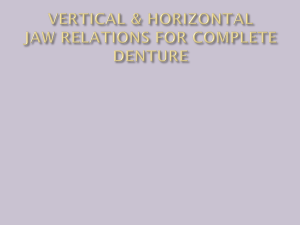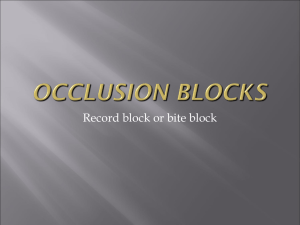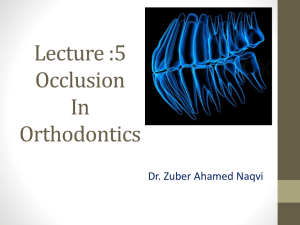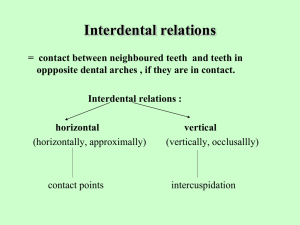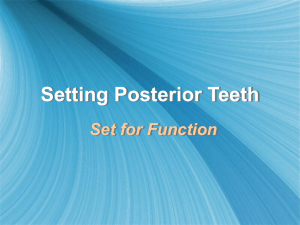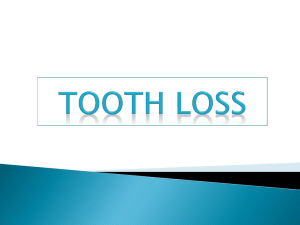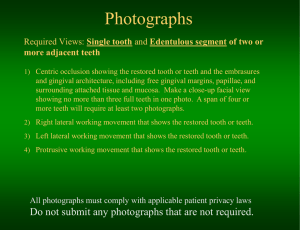File - Dr.Rola Shadid
advertisement
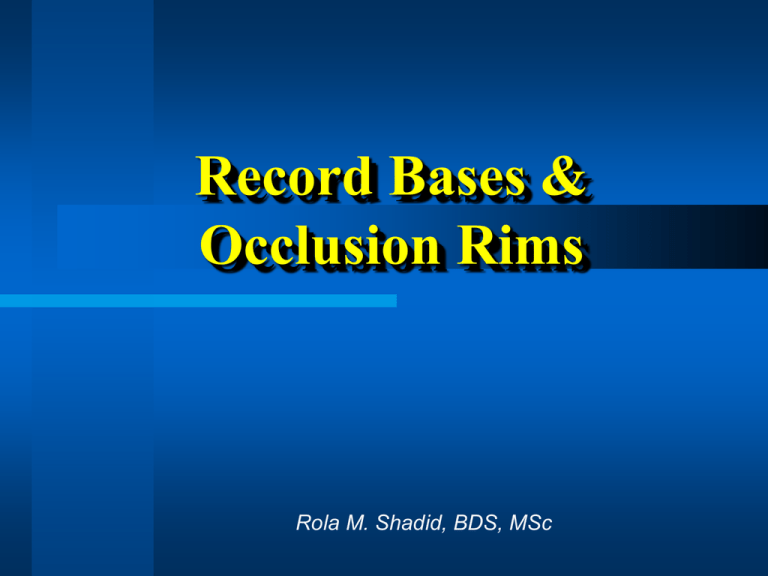
Record Bases & Occlusion Rims Rola M. Shadid, BDS, MSc Record Bases An interim denture base used to support the record rim material for recording maxillomandibular records The primary function is to serve as a base to fabricate and support the wax occlusion rims and trial dentures Record Bases & Occlusion Rims Wax occlusion rims simulate the position of the teeth Record Bases & Occlusion Rims Occlusion rims slightly bulkier to provide additional stability during record making Arbitrary Adjustment of Occlusion Rims (Refer to lab. manual) Adjust separately using average dimensions: Maxillary - 22 mm Mandibular - 18 mm Maxillary Occlusion Rim Adjustment Maxillary rim slightly facial to compensate for ridge resorption Mandibular Occlusion Rim Adjustment Centered over the ridge to maximize stability Mandibular Occlusion Rim Adjustment Posteriorly, the occlusion rim intersects 1/2 - 2/3 up the retromolar pad Requirements of Record Bases Well adapted Stable and retentive in mouth Rigid and dimensionally stable Smooth No more than 1 mm thick on the crest and facial slope of ridge 2 mm thick in the palatal and lingual slope region for rigidity Smooth and rounded borders Record Bases Temporary bases Permanent bases Temporary Record Bases’ Materials Shellac Autopolymerizing acrylic resin Vacuum formed vinyl or polystyrene Baseplate wax Permanent Record Bases’ Materials Heat cured acrylic resin Gold alloy Chrome cobalt alloy Chrome nickel alloy Swaged metal base Occlusion Rims Occluding surfaces fabricated on interim or final denture bases for making maxillomandibular relationship records and arranging teeth Uses of Occlusion Rims Determination of lip support Arch form Plane of occlusion Teeth size and position Contour of the polished surface Transfer jaw relation Arrangement of teeth References 1. Complete Denture Prosthodontics, 1st Edition, 2006 by John Joy Manapallil, Chapter 8 2. Dalhousie Continual Education Jaw Relations Basic Mandibular Positions 1) Rest position (physiologic rest position) PRP 2) Intercuspal position (maximum intercuspation, centric occlusion, tooth position) CO 3) Centric relation (ligamentous position, posterior border position, Retruded contact position ) CR Physiologic Rest Position (PRP) The vertical and horizontal position the mandible assumes when the mandibular musculature is relaxed and the patient is upright. When the mandible is in the rest position there is a space between the occlusal surfaces of the teeth which is known as the freeway space or interocclusal rest space. This space is wedge-shaped, being larger anteriorly where the separation between the teeth is most commonly within the range 2–4 mm. Physiologic Rest Position (PRP) At rest, lips barely touching Occlusion rims should not touch Intraorally no contact Occlusal Vertical Dimension (OVD) • The distance between two selected points, one related to the maxilla and one related to the mandible, when the upper and lower teeth are in contact. • When the mandible is in its resting position, this distance is the rest vertical dimension • The difference between the measurements is the freeway space. Occlusal Vertical Dimension (OVD) Distance between maxilla & mandible when teeth or wax rims contact in centric position Freeway Space or Interocclusal Distance (ID) Space between wax rims at physiologic rest position Usually 2-4 mm Variation in the Rest Position It is found that the rest position of the mandible was not constant throughout life. The rest position of the edentulous patient can be affected by short-term variables, and by long-term variables. Short-Term Variables Patient supine: Reduced Head tilted back: Increased Head tilted forwards: Reduced Insertion of lower denture or record block: Increased Stress: Reduced Pain: Reduced Drugs: Variable Long-Term Variables If the same dentures are worn for many years and are not maintained, a reduction in the occlusal vertical dimension occurs as a result of alveolar resorption and occlusal wear. The rest position of the mandible adapts to this change and takes up a position closer to the maxilla. As a result, the freeway space becomes larger. Long-Term Variables Where these changes have taken place in young patients, it is often possible to recover much of the lost vertical dimension when new dentures are constructed. However, with the elderly patient, any attempt to restore the occlusal vertical dimension to its original level may be met with problems. Long-Term Variables The long-term variables will not affect the reproducibility of the rest vertical dimension during the period of a dental appointment Intercuspal Position (Centric Occlusion) The intercuspal position is the vertical and horizontal position of the mandible in which maximum occlusal contact occurs. In the denture wearer, the intercuspal and centric relation positions should coincide. Centric Relation The maxillomandibular relationship in which the condyles articulate with the thinnest avascular portion of their respective disks with the complex in the anterior-superior position against the shapes of the articular eminencies. This position is independent of tooth contact. This position is clinically discernible when the mandible is directed superior and anteriorly. It is restricted to a purely rotary movement about the transverse horizontal axis (GPT-5) Centric Relation (CR) It is usually defined by the position of the condyles, rather than the teeth. Therefore it does not alter when the natural teeth are extracted or when a new occlusal surface replaces an unsatisfactory one. Centric relation can be thought of as a treatment position, which is not necessarily ideal or normal in the natural dentition. When to Use CR? When entire occlusion being restored (i.e. no remaining posterior centric stops) When complex fixed, or removable partial dentures involve the entire occlusion if a nonpathologic natural occlusion exists (posterior centric stops present), and there is no valid reason to change it, then restorations should be made in maximum intercuspation Significance of CR (Reasons for Using CR in Edentulous Patients) 1. Artificial teeth are best to occlude evenly at CR 2. Conducive to health - not pathogenic 3. Relatively repeatable (reproducable) over a period of time - so the patient can find stable occlusal contacts easily 4. A hinge position - allows change in the vertical dimension easily and so the patient can find stable occlusal contacts easily 5. A relatively symmetrical position - avoids muscle strain which might occur in excursive positions Significance of CR (Reasons for Using CR in Edentulous Patients) 6. This position is independent of presence or absence of teeth 7. If CR and CO of artificial teeth don’t coincide , there is instability of dentures and patient subjected to pain or discomfort Significance of CR (Reasons for Using CR in Edentulous Patients) 8. Allows function to all positions 9. 24% of normal population has CR=CO References 1. Basker’s Prosthetic treatment of the edentulous patient. Fourth edition. Chapter 5. 2. Dalhousie Continual Education
